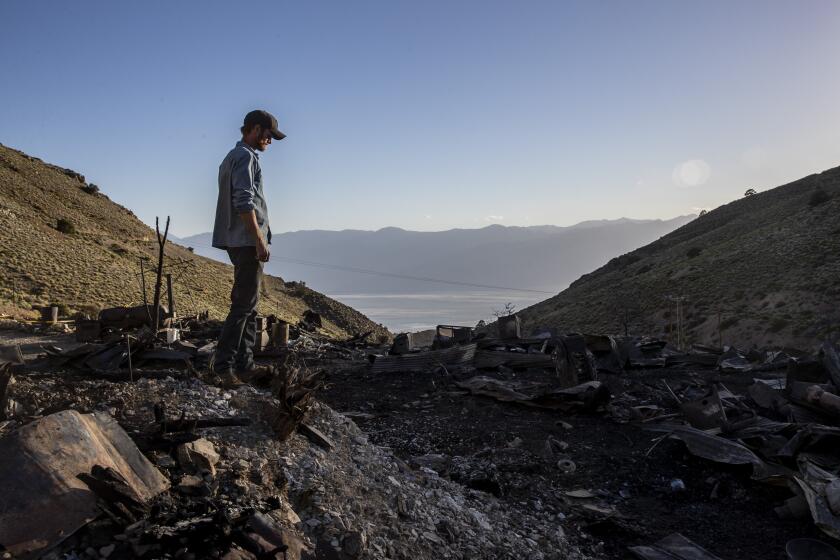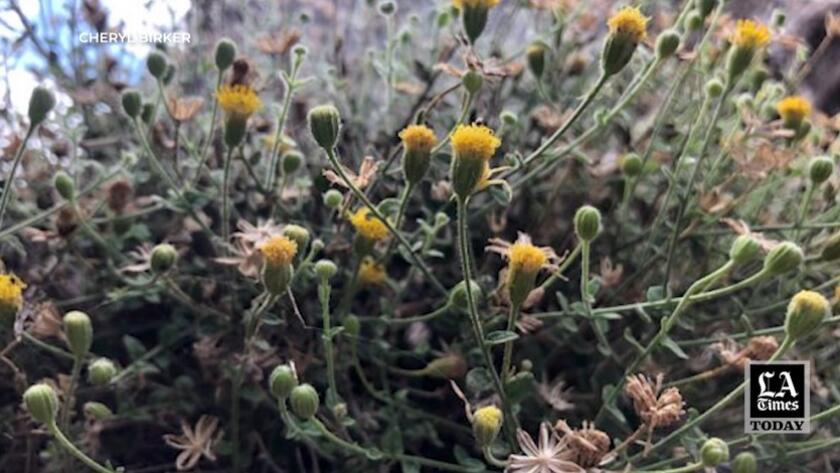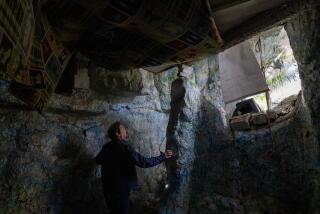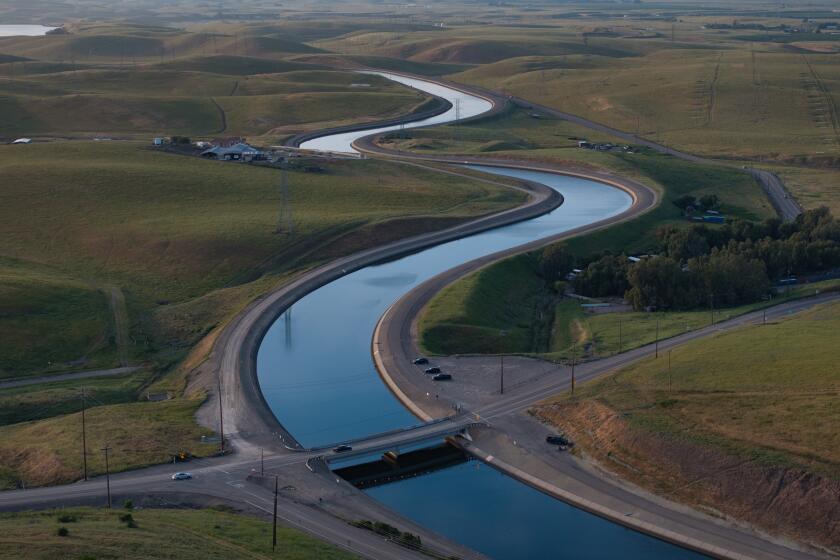It’s a fight to the finish for a rare daisy and a gold mine near Death Valley
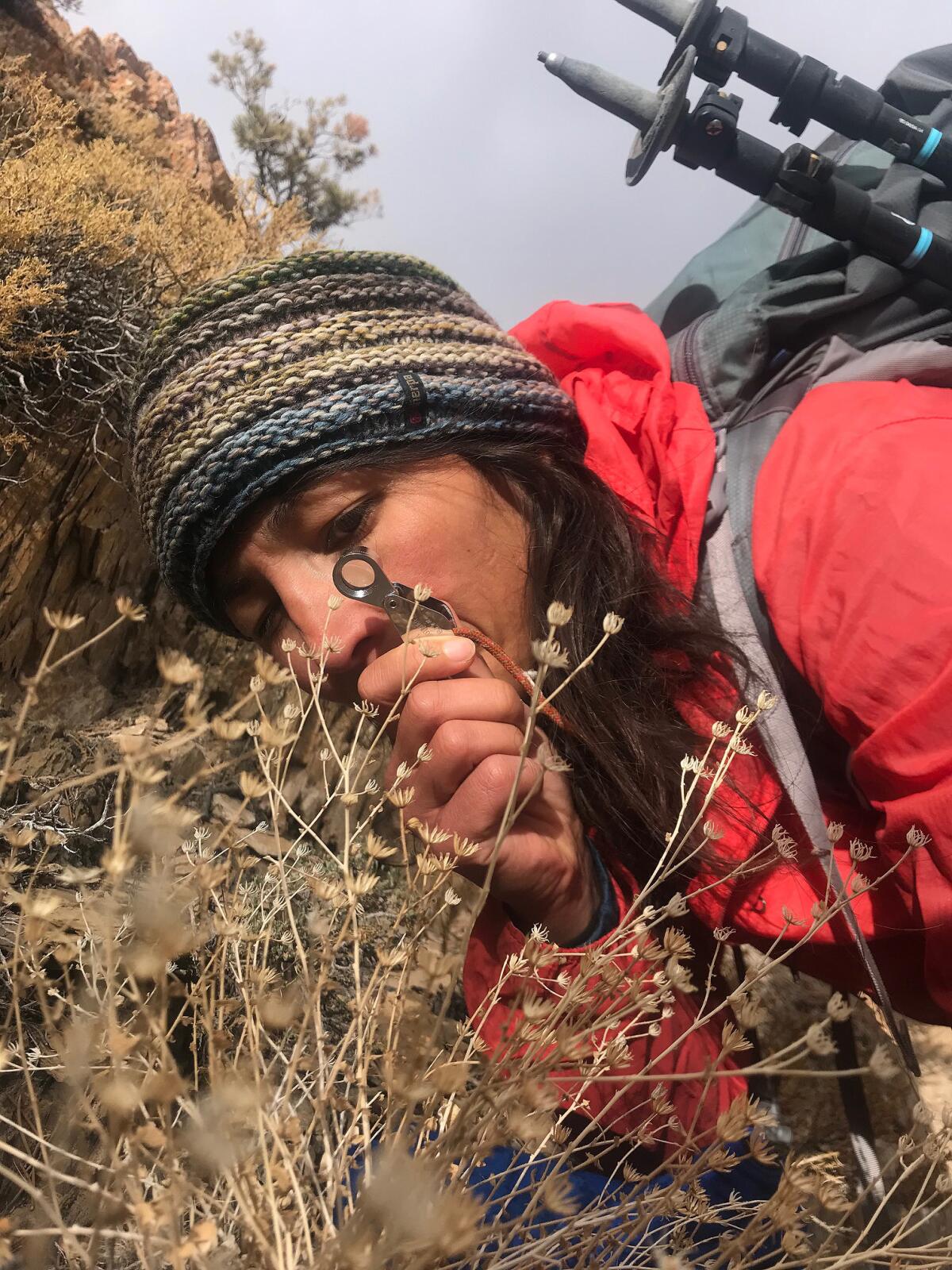
Botanist Maria Jesus has made a career out of trying to protect wild places where rare plants are making their last stand, and field work can mean bivouacking alone in a pup tent.
Take the Inyo rock daisy, which only grows in the crevices of cliff walls in two largely roadless areas of the southern Inyo Mountains near Death Valley National Park.
One is Conglomerate Mesa, a 22,500-acre chunk of piñon pines, rock spires and tilted beds of limestone. It’s also where K2 Gold Corp., of Vancouver, Canada, is drilling and trenching on public lands in hopes of laying the groundwork for a large-scale open pit mine.
The other is near privately-owned land in the nearby historic Cerro Gordo Mining District, which was recently sold to investors with plans to develop a ghost town into a tourist attraction.
Environmentalists and tribal leaders are fighting a plan by K2 Gold to sell its mining claims to a large corporation for development.
Saving an obscure daisy that occupies less than a cumulative square mile of the Earth’s surface means getting to know it. Jesus, 38, a conservationist at the nonprofit California Botanic Garden in Claremont, has spent 103 days over the last four years roaming the Inyo range’s scowling canyons and craggy peaks in search of details about its natural history.
The first time she laid eyes on Perityle inyoensis, she was hooked.
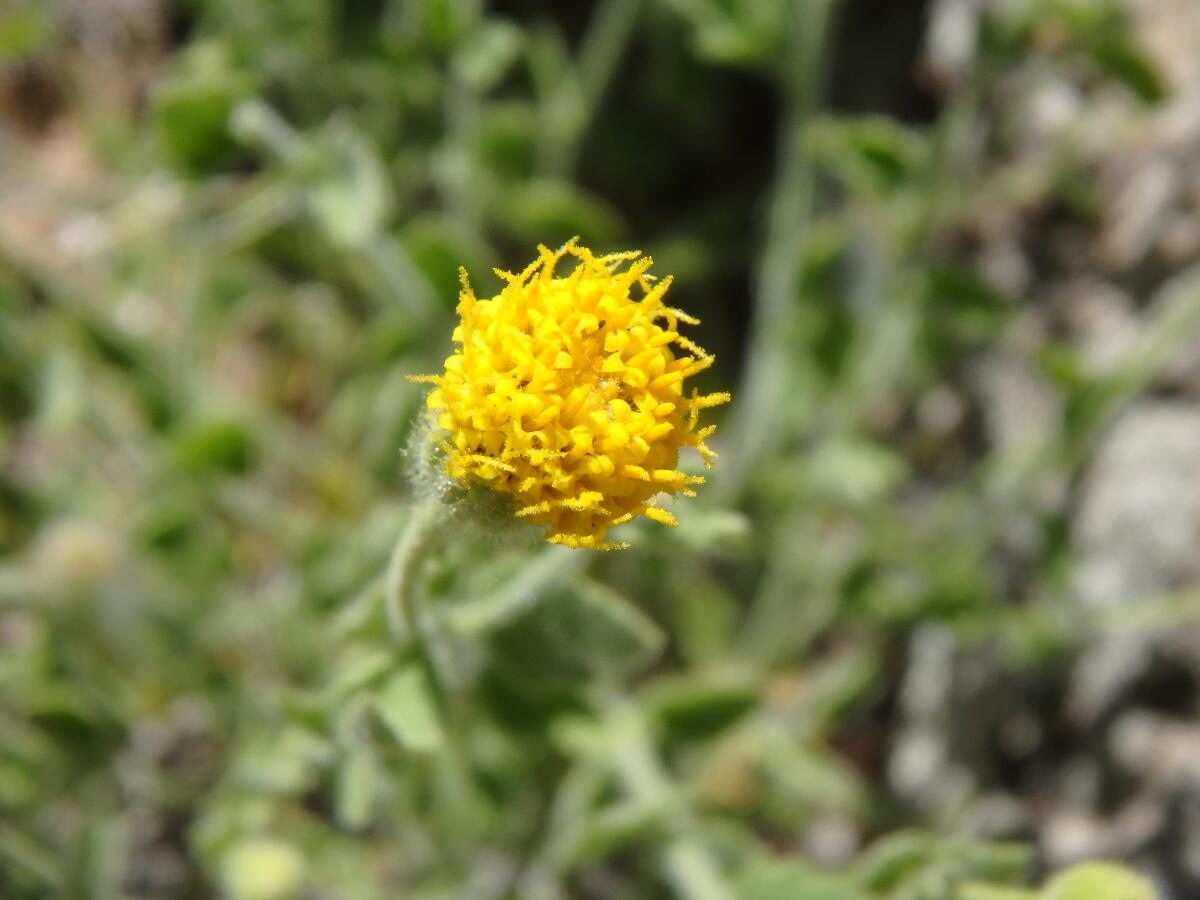
“It was all by itself on a cliff on a scorching summer day,” she recalled, “luring pollinating wasps into service with the pungent earthy aroma of its brilliant yellow flowers.”
“Right then and there,” she added with a proud smile, “I vowed to do everything in my power to ensure its survival.”
Earlier this month, Jesus and Ileene Anderson, a senior scientist at the Center for Biological Diversity, in conjunction with the California Native Plant Society, submitted petitions to the California Fish and Game Commission and the U.S. Fish and Wildlife Service seeking to have the Inyo rock daisy listed as a threatened or endangered species.
And they hope its listing, if approved, will bring a screeching halt to K2’s proposal to use tons of cyanide each day to leach gold from heaps of crushed ore, a technique that has transformed previously unprofitable mines into bonanzas.
The California ghost town of Cerro Gordo was once legendary for its violence. Now, a mysterious fire has destroyed its famed American Hotel.
In the meantime, Jesus has become a hero of sorts among environmentalists, tribal members and others who want to keep Inyo County’s lakes, streams, meadows, sweeping desert plains, volcanic fields, rural towns and cattle ranches in their current state — free of the clatter and disruptions of heavy industry.
K2 was unavailable for comment. But Wendy Schneider, executive director of Friends of the Inyo, summed up Jesus’ crusade this way: “Flower power — good stuff!”
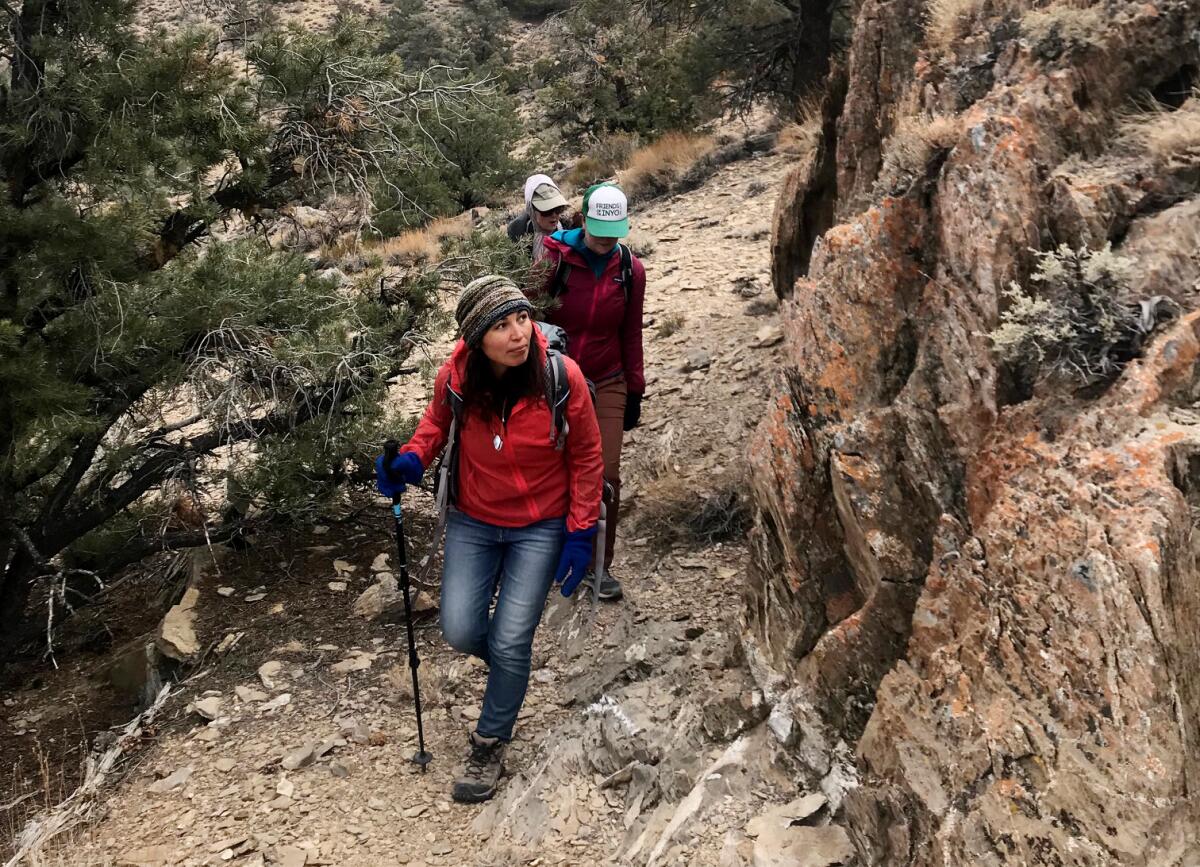
“Let’s find some daisies!” Jesus said on a recent morning, as she, Anderson, Kayla Browne, desert lands organizer at the nonprofit Friends of the Inyo, and a visitor set out on a trail across the arid mesa that is managed by the U.S. Bureau of Land Management and home to mountain lions, desert night lizards and most of the few dozen known occurrences of Inyo rock daisy.
Jesus has an extra awareness that researchers with years afield develop that guides her to steep, wind-punished slopes shared by the wildflowers and some of the several hundred mining claims K2 has acquired since 2019.
Finally, the group came to an abrupt stop and Jesus nodded appreciatively toward a small brown shrub protruding from a crack in a crumbly outcropping about 15 feet high that was dappled with brown moss and orange lichen.
“There’s our daisy!” Jesus said, extending her arms as if to embrace the plant, which stood in a drab, seemingly lifeless winter phase that only a botanist could cherish.
Although most of the daisy’s habitat in Conglomerate Mesa and Cerro Gordo is designated as part of the National Conservation Lands system, it remains open for commercial extraction under the 1872 Mining Law.
But the petition is igniting deep passions in struggling communities along U.S. Highway 395. The area has a legacy of historic mining, but now relies on tourists from Southern California to make cash registers sing in tackle shops, art galleries, restaurants and saloons with Old West facades.
Among those communities is Lone Pine, about 20 miles west of Conglomerate Mesa. The town of about 2,000 residents, about 100 miles south of the Sierra ski resort town of Mammoth Lakes, has a median household income of about $46,146, compared with $80,440 statewide, according to the U.S. Census Bureau.
There, too, K2 Gold, known locally as Mojave Precious Metals Inc., has opened an office just a few steps away from the Lone Pine Chamber of Commerce.
In addition to K2 Gold, federal land managers are weighing at least five controversial gold exploration projects by foreign companies along the nearby eastern Sierra Nevada range. Just outside Mammoth Lakes, for instance, KORE Mining, a Canadian company, is exploring the feasibility of open pit mining under U.S. Forest Service oversight. Some fear the endeavor could overwhelm the peaceful ambience along Hot Creek, a fly-fishing hot spot about 300 miles north of Los Angeles.
Whether any of the claims being staked throughout the mineral-rich region blossom into full-blown mines remains to be seen, but the price of gold surged to about $2,000 per ounce in the wake of Russia’s military action in Ukraine.
Matt Kingsley, an Inyo County supervisor representing a district that includes the southern Inyo Mountains, said he was “not surprised” that conservationists “are throwing everything they can at these gold mining proposals — this is their latest tactic.”
“But the plants in question,” he suggested, “have obviously thrived and survived; and it may be possible that they will be fine with any mine.”
Jesus is not so sure. And when it comes to the Inyo rock daisy, she knows as much as anyone.
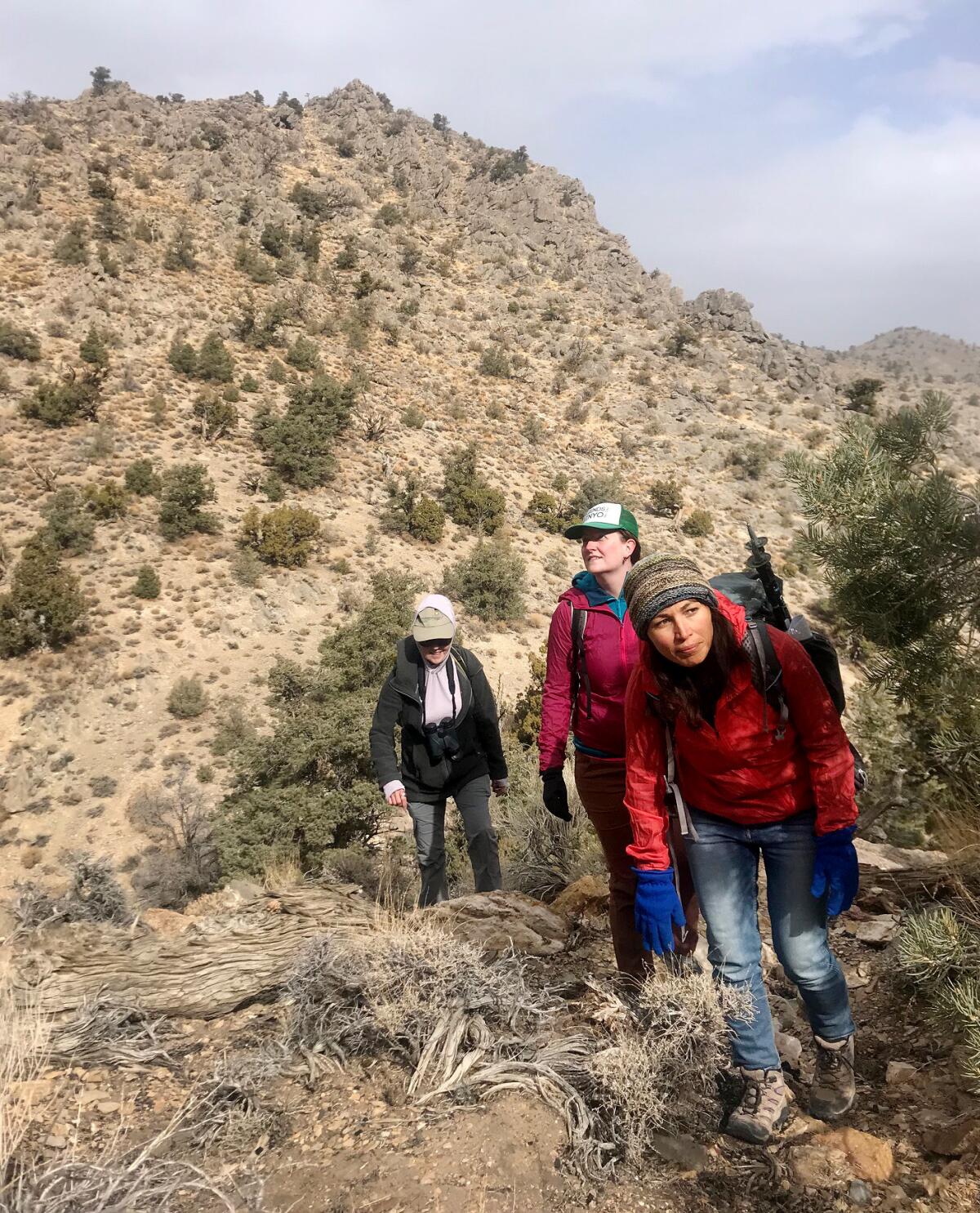
The thesis for her master’s degree at Claremont Graduate University required roaming the Inyo Mountains along four-wheel-drive dirt roads and hiking no-nonsense trails as part of an effort to map the extent of the daisy’s home range.
While searching for evidence of the plant in the vicinity of Cerro Gordo, she spent a night alone in a pup tent just a stone’s throw from a century-old cemetery. “I didn’t get much sleep that night,” she said.
Other measures of her dedication to the cause include handing out buttons featuring color photos of the daisy in bloom and producing a virtual tour of the plant’s minuscule empire aimed at answering a fundamental question: Why should anyone care about a few daisy plants in a place only visited by a few intrepid hikers each year?
It’s the kind of question that fueled the earlier explorations of a woman Jesus and Anderson both regard as a personal hero: Mary DeDecker, a botanist who amassed a massive archive of information on native plants of the Inyo Mountains and eastern Sierra Nevada range and urged residents to fight development proposals that threatened their survival. DeDecker died in 2000 at the age of 91.
“She was crusty, and tireless,” Anderson recalled, “and an inspiration for new generations of naturalists.”
Jesus could not agree more. But regulatory gears move slowly.
State and federal wildlife authorities may not take the petition under consideration until August, and K2 has requested permission to grade dirt roads on the mesa as part of an effort to increase its exploratory drilling activities.
“These wildflowers may have endured decades of historic mining,” Anderson said, “but they don’t stand a chance against a combination of modern industrial-scale operations and extreme climate shifts.”
Indeed, distressing signs abound that more frequent droughts and record-breaking heat waves are taking a toll on the region’s fragile ecology. Animals desperate for food and moisture, for example, have eaten the bark off the trunks of thousands of Joshua trees in the area.
It’s added a layer of urgency to Jesus’ efforts to gather more daisy facts that could become keys to its long-term survival.
During the recent hike, as gusts of wind and snow pummeled the mesa, Jesus dropped to her knees for a closer look at a lone daisy clinging to existence on an outcrop surrounded by mining claims. Peering through a powerful hand lens, she smiled and said: “Hang in there.”
Watch L.A. Times Today at 7 p.m. on Spectrum News 1 on Channel 1 or live stream on the Spectrum News App. Palos Verdes Peninsula and Orange County viewers can watch on Cox Systems on channel 99.

